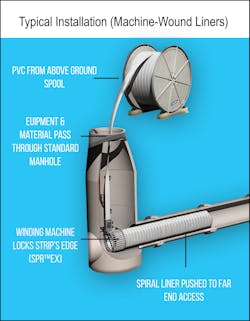Spiral wound lining is a trenchless technology that uses continuous strips of plastic (typically PVC or HDPE) to fully restore gravity pipelines from 6 inches to over 200 inches in diameter. This unique rehabilitation method first originated in Australia and Japan during the 1980s. Now, with four decades of installation history, spiral wound has been used on millions of feet of pipe in the United States and across the globe. Like CIPP or sliplining, spiral wound liners provide a structural lining solution for fully deteriorated pipelines with minimal site disruption.
The category of spiral wound rehabilitation includes two fundamentally different methods of installation; mechanically (machine)- and manually (hand)-wound liners. These vary by manufacturer and possess unique features and benefits. Both, however, typically involve a continuous strip of PVC material that is spirally wound to form the new pipe. The following is an overview of spiral wound technology; the differences within the category and the comparable features/benefits to other well-known rehab methods.
Material & Design
The typical PVC used for rehab is similar to what is used for new pipe construction. Manual- and mechanically-wound liners both feature a ribbed profile design, which provides added stiffness to the liner material. These ribs face towards the pipe for installation, exposing the smooth PVC face as the interior of the pipeline. This results in spiral wound possessing favorable hydraulic qualities post-installation; the Manning’s n (a roughness coefficient) value post-lining is typically between 0.009 and 0.010.
Along with the ribbed design, the PVC strip contains a male and female locking mechanism on its edge. This locking mechanism typically features a gasketing material as well, ensuring a seal that is impermeable to infiltration/inflow and root intrusion.
Although the spiral wound processes often use the same material (PVC) and ribbed design, the height, thickness, and inner components of the PVC strip vary by manufacturer. For instance, machine-wound PVC may be steel-embedded depending on the application. The steel not only structurally reinforces the liner, but it also allows non-round applications to keep their shape. The actual size of the strip differs as well. The hand-wound PVC strip is typically wider than the machine-wound strip.
Industry Standards
Spiral wound adheres to ASTM standards for trenchless rehabilitation projects. The main difference is the machine-wound standard compared to the hand-wound. Machine-wound manufacturers comply with ASTM 1741-18, the standard practice for installation of machine spiral wound PVC liner pipe for the rehabilitation of existing sewers and conduits. This contrasts with hand-wound manufacturers, which follow ASTM F1735-09, the standard specification for PVC profile strip for PVC liners for the rehabilitation of existing man-entry sewers and conduits.
Applications
Spiral wound liners are used to restore gravity pipe systems, such as sewers, storm drains, and culverts. This includes pipe materials such as concrete, brick, clay, CMP, and others. Additionally, spiral wound liners are capable of renewing round and non-round shapes, as well as pipelines with radius bends.
Again, the full range of capabilities for spiral wound differs between the two methods of installation. For instance, manual-lining is utilized for new pipe construction as well as manhole rehabilitation. Hand-winding is also possible for structures as a partial-lining solution, not the entire 360 degrees. This contrasts mechanically-wound liners, which are only used for 360-degree pipeline rehabilitation. Furthermore, hand-winding requires grout in the annular space. This is opposed to machine-winding within circular pipelines from 6 to 60 inches. At this range of diameter, certain mechanical-winding methods allow the liner to be in intimate contact with the host pipe, resulting in no annular space.
The diameter range for machine-wound renewal spans from 6 inches to over 200 inches, and different machine-wound methods cover subsets of this 6- to over 200-inch range. For instance, SPR EX is a tight-fitting mechanically-wound method serving diameters from 6 to 42 inches. This contrasts SPR, a machine-wound method from 36 to 217 inches that requires annular space grouting. Manually-wound liners require man entry, resulting in larger-diameter capabilities. Typically, these liners renew pipes starting at 36 inches and above.
The machines for mechanical winding will also either perform static or traverse winding. The SPR EX static winding machine sits at the entrance of the pipe while pushing the PVC liner towards the far end manhole. SPR features a traverse winding machine, which pulls the strip to form the liner while traveling the length of the pipeline.
Spiral Wound Installation Process
The liners are constructed directly on site using mechanical winding machines or manual force. The profile strip is delivered to the site either on a spool or in coils that sit near the access point. The strip is then fed through the access and wound within the pipe to form the liner. The edges of the strip are locked as successive wraps of PVC are introduced within the pipeline.
For machine-wound liners, the mechanical pressure locks and impermeably seals the liner together. This is done by rollers or a winding cage that is powered hydraulically. For hand-wound liners, the male and female locks are joined and subsequently locked together by installing a strip within the joint. The strip is made from gasketing material and creates a water-tight seal. This strip is installed by the crew using a pneumatic palm hammer.
Below are the typical steps from pre-lining to post-lining.
- Pipe Cleaning & Inspection
The pipe is cleared of debris and inspected to confirm pipe conditions. If laterals are present, their locations are marked via CCTV. - Spiral Wound Installation
An above-ground spool/coil feeds PVC profile strips directly inside the pipeline where the liner is constructed. - Sealing & Reinstatement
The PVC liner’s ends are sealed, and services are reinstated. - Post-Rehab Evaluation
The PVC liner is inspected to ensure the rehabilitation process was a success.
Spiral wound technology boasts innovative qualities as a category. These include the ability to install in live flow, fully structural capabilities, and a minimal construction footprint. Both machine-wound and hand-wound liners also provide flexibility when it comes to the project location, pipe offsets, and job site unpredictability.
Live Flow Installation: The ability to install liners in live flow is a key feature for mechanically and manually-wound PVC liners. That being said, the acceptable live flow conditions vary. For machine-wound liners, typically up to 30% low-velocity flow is permittable for installation. This allows for limited or even no bypass for pipe rehab projects that would otherwise require mandatory bypass pumping.
Structural & Hydraulic Renewal: Spiral wound liners can be designed for fully structural renewal. This varies by manufacturer; the machine-wound liner is a fully structural, stand-alone liner for circular pipelines. The result is the actual PVC liner being structural, as opposed to the hand-wound composite system which typically requires both liner and grout for structural integrity. Additionally, although cross-sectional reduction occurs, Spiral Wound often improves hydraulic qualities due to a Manning’s n value of 0.009 to 0.010.
Minimal Above Ground Footprint: The above-ground footprint of spiral wound lining is minimal. The staging area varies by installation method; either a spool or coil of PVC sits above ground while the work occurs directly inside the pipeline. For larger-scale projects, multiple spools/coils of profile will be onsite to meet the daily production requirements.
Spiral wound uses existing access points to complete rehab projects. This means no pit excavation or backfill. The winding machine can be disassembled to pass through existing manholes and subsequently reassembled directly inside the pipeline.
Flexibility Onsite: With spiral wound being an entirely chemical-free technology, there is no styrene or contaminated process waters to dispose of. The process involves no cure times. This is beneficial especially for culvert rehabilitation projects involving streams. Since spiral wound can be installed in live flow without chemicals, existing streams are left unharmed. The installation also allows the contractor to start or stop at any point during the installation as needed.
Additionally, spiral wound technology is capable of handling remote access applications. With limited equipment and the transferable nature of the PVC lining process, spiral wound makes difficult or remote access projects possible.
Technology Advancements
Spiral wound lining is a continuously evolving trenchless technology. Capabilities within the United States have increased significantly over the past few decades as new manufacturers have entered the market. Liners are now available for a wider range of diameters. New profiles and state of the art installation equipment are continuously being introduced to meet a wider range of applications. Contractors understand the constructability and environmental advantages of using spiral-wound liners, which are now a part of their trenchless toolbox







